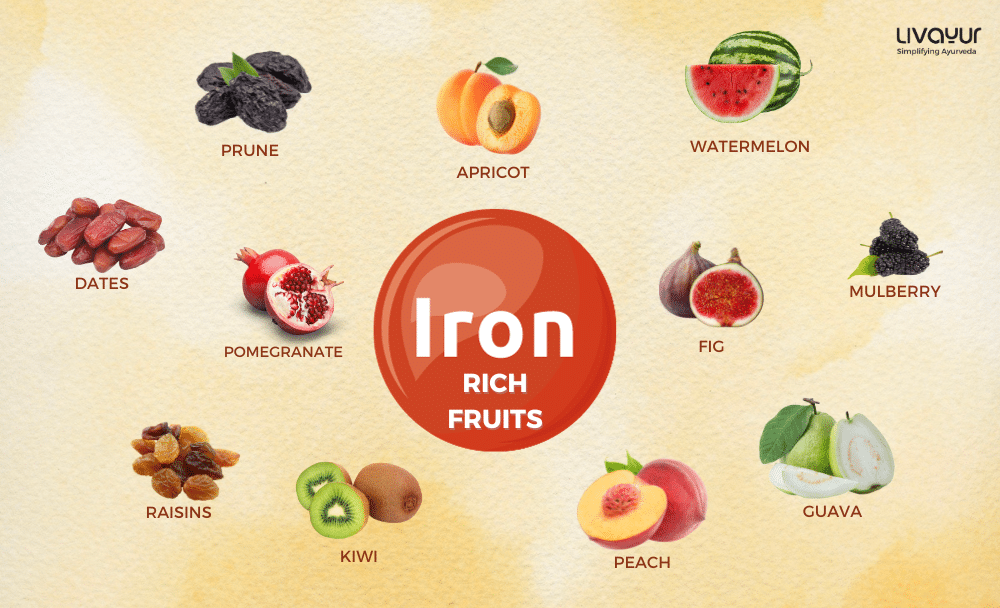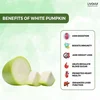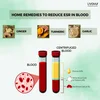
Ayurveda emphasizes that dietary choices are significant in maintaining optimal health. Iron, essential for various physiological functions, is critical in Ayurvedic principles. According to Ayurveda, incorporating iron-rich fruits into your diet can address the body’s nutritional requirements and align the elemental balance essential for overall health. This article looks at 15 fruits rich in iron content. We will also look at other iron-related aspects to help you make informed choices about your health.
Key facts about iron
- Men in the age group of 19-50 require 8 mg of iron daily.
- Pregnant women require 27 mg.
- Dried apricots are the healthiest source of iron, with approximately 2.7 mg of iron per 100 gm.
- Tea and coffee are one of the inhibiting factors for iron absorption.
What is iron?
Iron is a crucial mineral for maintaining robust health and plays an important role in sustaining healthy blood. Iron deficiency anemia is one of the most prevalent nutritional deficiencies globally. It can lead to symptoms like extreme fatigue and light-headedness. This deficiency poses a particular risk to children, pregnant or menstruating women, and individuals undergoing kidney dialysis.
The core of iron’s significance is its primary component of hemoglobin. It is a protein residing in red blood cells that facilitates the transportation of oxygen from the lungs to every corner of the body. Inadequate iron levels diminish red blood cell count and lead to fatigue. Iron is also a vital constituent of myoglobin, a protein essential for storing and transporting oxygen within muscle tissues.
Beyond its circulatory functions, iron is essential for fostering healthy brain development in children. Iron comes from dietary sources in two forms: heme, which is exclusively in animal products, and non-heme, which is from plant-based foods like whole grains, nuts, seeds, legumes, and leafy greens. [1]
Recommended dietary intake of iron
Ensuring an adequate iron intake is imperative for individuals across various life stages. The recommended dietary intake varies based on age, gender, and physiological conditions. Here’s a breakdown of it.
Adults (19-50 years) [1]
| Age group | Requirement |
| Men | 8 mg of iron daily |
| Women | 18 mg of iron daily |
| Pregnancy | 27 mg of iron daily |
| Lactation | 9 mg of iron daily |
During the reproductive years, women require a higher daily intake to accommodate the additional iron demands associated with menstruation and potential pregnancy.
Adolescents (14-18 years) [1]
| Age group | Requirement |
| Boys | 11 mg of iron daily |
| Girls | 15 mg of iron daily |
| Pregnancy | 27 mg of iron daily |
| Lactation | 10 mg of iron daily |
Adolescents, particularly those undergoing active growth, necessitate increased iron intake to support the rapid development of their bodies. The elevated requirements during pregnancy and lactation emphasize the importance of meeting nutritional needs during these critical life stages.
Women (51+ years) [1]
- 8 mg of iron daily
For women aged 51 years and older, the recommended daily intake drops to 8 mg. The adjustment is on the assumption that menopause has occurred. It can lead to the cessation of menstruation and reduced iron requirements.
15 fruits that are super rich in iron
Here are 15 celebrated fruits rich in iron.
1. Dried apricots
With approximately 2.66 mg of iron per 100g, dried apricots offer a sweet and nutrient-dense snack. [6]
2. Prunes
Rich in fiber and iron, prunes provide about 0.93 mg of iron per 100g, simultaneously promoting digestive health and iron intake. [7]
3. Raisins
A natural energy booster, raisins contain 1.9 mg of iron per 100g, making them one of the best iron-content fruits. [8] .
Want to know more about raisins? Read our related article on – 15 Amazing Benefits Of Raisins And How To Consume It
4. Dates
Dates offer multiple benefits. Known for their natural sweetness, dates contribute 0.3-10.4 mg of iron per 100g, and offer a wholesome alternative to refined sugars. [9]
5. Mulberries
These berries pack a punch with approximately 1.9 mg of iron per 100g, adding flavor to cereals or desserts. [10]
6. Guavas
With 0.3 mg of iron per 100g, guavas provide a tropical flair and contribute to rich iron-content fruits. [11]
7. Pomegranates
Renowned for their antioxidant properties, pomegranates contain about 0.3 mg of iron per 100g, enhancing overall nutritional value. [12]
8. Kiwi
In addition to being a vitamin C powerhouse, kiwi offers 0.5 mg of iron per 100g, supporting iron absorption. [13]
9. Passion fruit
With a unique flavor profile, passion fruit delivers 1.6 mg of iron per 100g, making it a tasty and nutritious option. [14]
10. Black currants
These berries boast 3.3 mg of iron per 100g and a wealth of antioxidants, contributing to overall well-being. [15]
11. Strawberries
Apart from their refreshing taste, strawberries contain 0.41 mg of iron per 100g, making them a delightful iron-content fruit. [16]
12. Watermelon
Hydrating and low in calories, watermelon provides 0.2 mg of iron per 100g, adding a juicy twist to iron intake. [17]
13. Papaya
A tropical delight, papaya contributes 0.23 mg of iron per 100g, alongside a host of other essential nutrients. [18]
14. Avocado
Known for its healthy fats, avocado contains 0.55 mg of iron per 100g, offering a creamy addition to iron-rich salads or dishes. [19]
15. Figs
Dried figs provide a concentrated source of iron, offering approximately 2.2 mg per 100g, coupled with dietary fiber. [20]
Read our related article on the Digestive Benefits of Dried Anjeer or Figs
Factors affecting iron absorption
Here are the various factors that can hinder dietary iron absorption.
1. Tea
The tannins in tea, mainly found in black and green varieties, contain polyphenolic compounds that can bind to non-heme iron. They form complexes that are less readily absorbed by the body. [2]
2. Coffee
Similar to tea, coffee contains polyphenols that can impede non-heme iron absorption. Consuming coffee alongside iron-rich meals may reduce the bioavailability of this essential mineral. [2]
3. Soy products
Certain compounds in soy products, like phytates, can hinder iron absorption. While soy-based foods contribute to a well-rounded diet, individuals may benefit from strategic iron-rich pairings. [2]
4. Ethylenediaminetetraacetic Acid (EDTA)
Commonly used as a food preservative, EDTA can form complexes with minerals, including iron, to limit their absorption. Processed foods containing EDTA may warrant attention for those monitoring iron intake. [2]
5. Calcium/Phosphate
High calcium and phosphate levels, often found in dairy products, can compete with iron for absorption. Consuming these nutrients in moderation and strategically timing meals can mitigate potential interference. [2]
6. Eggs
While eggs contain heme iron, which is more easily absorbed than non-heme iron, they also contain compounds that may inhibit overall iron absorption. Balancing egg consumption within a diverse diet is critical. [2]
7. Wheat bran
The high content of phytates in wheat bran can hinder iron absorption. Incorporating a variety of grains and cereals or considering alternative sources of fiber may be beneficial for those aiming to optimize iron absorption. [2]
8. Fiber
Dietary fiber, while crucial for digestive health, can impede the absorption of non-heme iron. Consuming fiber-rich foods alongside iron-rich sources may necessitate thoughtful meal planning to ensure optimal nutrient absorption. [2]
How to improve iron absorption
Here are some essential methods to optimize iron absorption.
1. Use Vitamin C
Citrus fruits (e.g., oranges), tomatoes, and strawberries can increase the absorption of non-heme iron. It is the type of iron found in plant-based foods like beans, nuts, and fortified cereals. [5]
Want to know which foods are good sources of iron? Discover The Best Vitamin C-rich foods
2. Timing
If you regularly consume tea or coffee, limiting your intake between meals and iron supplement consumption is advisable. Tea and coffee contain tannins that limit iron absorption when consumed concurrently with iron-rich foods or supplements. [5]
3. Include Vitamin C in every meal
You can achieve it by adding orange juice, citrus slices, or other vitamin C-rich options to your daily meals. When consumed alongside foods that are highly rich in iron or supplements, vitamin C helps convert non-heme iron into a more absorbable form. [5]
Side effects of excessive iron intake
Here are the various problems that can arise due to excessive intake of iron.
1. Digestive discomfort
High doses of iron supplements, especially when taken on an empty stomach, can cause digestive distress in healthy individuals. Common symptoms include upset stomach, constipation, nausea, abdominal pain, vomiting, and diarrhea. [3]
2. Gastrointestinal complications
Excessive iron intake may cause more severe gastrointestinal disorders. It includes inflammation of the stomach lining and the development of ulcers. These complications can contribute to persistent discomfort and compromise digestive health. [3]
3. Zinc absorption interference
Elevated iron levels can adversely affect the absorption of other essential minerals, like zinc. This interference can disrupt the delicate balance of micronutrients, potentially leading to nutritional imbalances. [3]
4. Organ dysfunction
Extremely high doses of iron, often in the hundreds or thousands of milligrams, pose a significant risk of organ failure. Vital organs, including the liver and heart, may be adversely affected. [3]
5. Neurological effects
Excessive iron intake can result in neurological complications, ranging from coma to convulsions. These severe effects highlight the importance of adhering to recommended iron intake levels. [3]
6. Child safety concerns
Children are particularly vulnerable to accidental iron poisoning due to their explorative nature and potential for ingesting supplements. Child-proof packaging and clear warning labels on iron supplements have proven effective in reducing the incidence of unintentional iron poisonings in children. [3]
7. Mortality risk
In extreme cases, the ingestion of exceptionally high doses of iron can be fatal. Organ failure, severe convulsions, and the risk of slipping into a coma highlight the importance of exercising caution in iron supplementation. [3]
Iron consumption and hemochromatosis
Excessive iron consumption can impact health. Consult a healthcare professional before incorporating iron supplements into your regimen. Haemochromatosis, a genetic condition affecting approximately 1 in every 200 individuals, is due to an abnormal absorption and storage of iron in the body.
Healthcare professionals detect it by screening individuals with close relatives diagnosed with it. It can lead to iron overload and pose serious health risks. Given the prevalence of this genetic disposition, discussing concerns regarding iron levels with your healthcare provider is crucial. Regular check-ups and open communication with medical professionals can ensure timely detection and management of hemochromatosis. [4]
Symptoms of iron deficiency
Here are the various symptoms associated with iron deficiency.
1. Fatigue and weakness
Iron deficiency can lead to a pronounced sense of fatigue and weakness, impacting overall energy levels and daily functioning. [1]
2. Light-headedness
Individuals with insufficient iron may experience light-headedness, contributing to unsteadiness or dizziness. [1]
3. Confusion and loss of concentration
Cognitive functions may get impaired, leading to confusion and difficulty concentrating. It can reflect the impact of inadequate iron on brain health. [1]
4. Sensitivity to cold
Iron deficiency can result in heightened sensitivity to cold temperatures, with affected individuals feeling unusually cold even in moderate conditions. [1]
5. Shortness of breath
Inadequate iron levels can compromise the efficient transport of oxygen in the body. It can cause shortness of breath even during routine activities. [1]
6. Rapid heartbeat
Anemia resulting from iron deficiency may lead to a rapid heartbeat, a compensatory mechanism as the heart works harder to circulate oxygen-deprived blood. [1]
7. Pale skin
Iron deficiency affects the production of hemoglobin. It is the pigment responsible for the red color of blood. As a result, individuals may exhibit paleness in the skin and mucous membranes. [1]
8. Hair loss and brittle nails
Insufficient iron can impact the health of hair and nails, leading to hair loss and increased brittleness in the nails. [1]
9. Pica
A unique symptom of iron deficiency is pica, an unusual craving for non-nutritive substances like ice, dirt, or starch. This behavior can be indicative of underlying nutritional deficiencies. [1]
Steps to overcome iron deficiency
If you suspect iron deficiency and are experiencing associated symptoms, initiating a conversation with your healthcare provider is the first crucial step. A doctor can guide you through the following measures to overcome iron deficiency.
1. Blood tests
Your doctor may order blood tests to ascertain your iron levels and confirm the presence of iron deficiency. These tests can provide valuable insights into various indicators, including hemoglobin and ferritin levels.
2. Dietary evaluation
A referral to a dietitian may be essential to assess your dietary habits and identify opportunities for improving iron intake. A balanced and nutrient-rich diet, including sources of both heme and non-heme iron, is integral to addressing iron deficiency.
3. Supplementation guidance
Based on the severity of your iron deficiency, your doctor may suggest iron supplements to boost your levels. These supplements come in various forms, and your healthcare provider can provide specific recommendations tailored to your needs.
FAQs
1. Which fruit has the highest iron?
Among fruits, dried apricots are known for having relatively high iron content. [6]
2. What are ten iron-rich foods?
Iron-rich foods include lean meats, poultry, fish, beans, lentils, tofu, fortified cereals, spinach, dried fruits, and nuts.
3. Is Apple rich in iron?
While apples contain a small amount of iron, they are not one of the fruits high in iron. Other fruits like dried apricots or raisins have higher iron content. [6]
4. Is Mango rich in iron?
Mangoes, while delicious and nutritious, are not one of the fruits high in iron. Consider incorporating other fruits like dried apricots or prunes for higher iron content. [6]
5. Is pomegranate iron-rich?
Pomegranates contain some iron but are not one of the fruits high in iron. Consider incorporating other sources like dried fruits or leafy greens for a more substantial iron boost.
Conclusion
The incorporation of iron fruits into your diet introduces delightful flavors and textures. Furthermore, it is a strategic approach to addressing your body’s nutritional needs. The 15 iron fruits highlighted here offer a delectable means to fortify your body with this essential mineral. However, it is crucial to approach iron intake with balance, keeping in mind your dietary requirements and potential factors that may influence iron absorption. As with any nutritional adjustments, consulting healthcare professionals ensures an informed approach.
Disclaimer
The information provided here is not intended to replace professional advice or treatment.
References
- Iron | The Nutrition Source
- Factors Affecting the Bioavailability of Dietary Iron
- Iron Fact Sheet for Consumers
- Foods high in iron
- Iron Deficiency and Anemia
- Apricots, dried, sulfured, uncooked
- Plums, dried (prunes), uncooked
- Raisins, dark, seedless (Includes foods for USDA’s Food Distribution Program)
- The Effect of a Date Consumption-Based Nutritional Program on Iron Deficiency Anemia in Primary School Girls Aged 8 to 10 Years Old in Zahedan (Iran)
- Mulberries, raw
- Guavas, common, raw
- Pomegranates, raw
- Kiwifruit, green, raw
- Passion-fruit, (granadilla), purple, raw
- Currants, zante, dried
- Strawberries, raw
- Watermelon, raw
- Nutrition Facts Papayas, raw, 1 cup, mashed
- Avocado, raw
- Figs, dried, uncooked


















